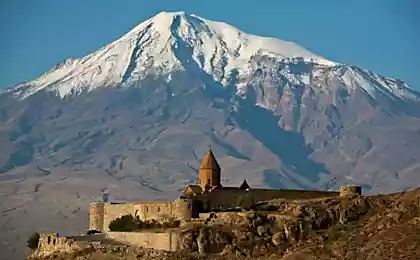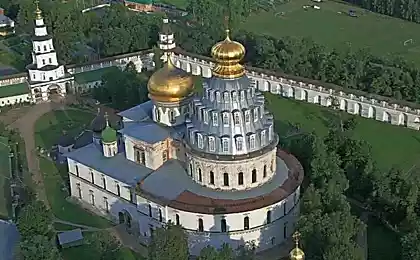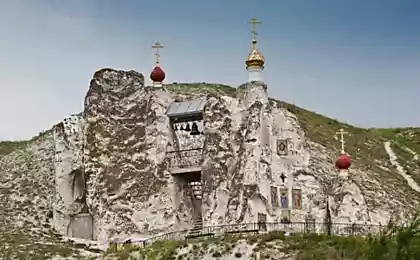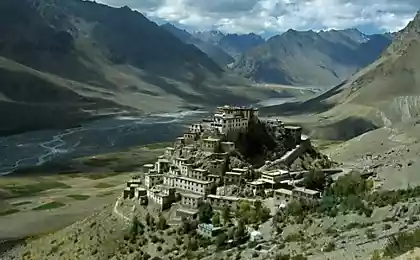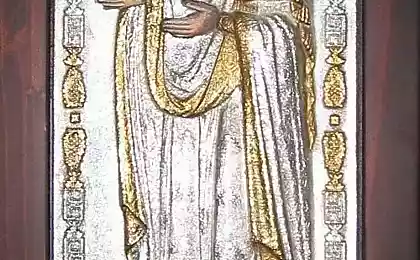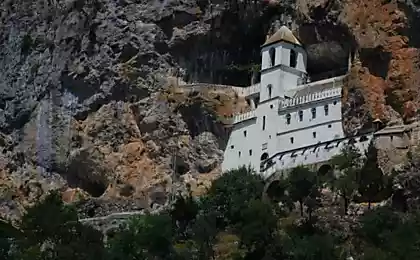2197
Tour of the monastery
Near the Sicilian town of Santo Stefano Kviskvina is a small monastery. It is situated next to one memorable place that is associated with one of the famous Catholic saints, the patroness of Sicily Rosalia. Today we will go to the monastery and learn a lot about the life of a hermit monk. Pious daughter of a wealthy Norman lord Sinibaldi (a direct descendant of Charlemagne) Rosalia still in adolescence renounced secular life and voluntarily settled in a tiny cave in the forest, which was owned by her family. It was around 1150. The girl held captive in the twelve long years, and then, as the cave and found out the locals began to disturb her peace, she moved to another under the same cave on Mount Pellegrino Palermo, where he died soon. The first mention of Saint Rosalia date back to 1590, about the same time in the cave were found the remains of Rosalia. It is believed that she was in the city, which threatens the plague, in the guise of a patient and pointed out where her remains so that they moved to the main church in Palermo - after this vision plague receded. Rosalia was kanonizirova in 1630 and has since been considered the patroness of Sicily.
A monastery, which I'm going to tell, there was where in 1624, two local residents found the very first cave where Rosalia held for twelve years. Cave found on the inscription on the stone: «Ego Rosali Sinibaldi quisquine et rosarum domini filia amore Domini Mei Jesu Cristi ini hoc antro habitari decrevi» (in Russian something like this: "I, Rosalia Sinibaldi, the daughter of the owner of these forests, decided to live in this cave of love for the Lord God Jesus Christ. "The discovery was seen as a miracle, and at this point there was a chapel.
A few years later a merchant from Genoa Francesco Skassi heard the story of Saint Rosalia, decided to go to Sicily and invest all your money in the construction of the monastery. After that, he stayed in the monastery to form with three hermits independent Brotherhood followers Saint Rosalia. Over time, the Brotherhood was able to organize your life in such a way as to be completely independent from the outside world: in addition to cooking, they grew vegetables, made bread, wine, fabrics, shoes, and everything else needed for a simple life of monks, hermits.
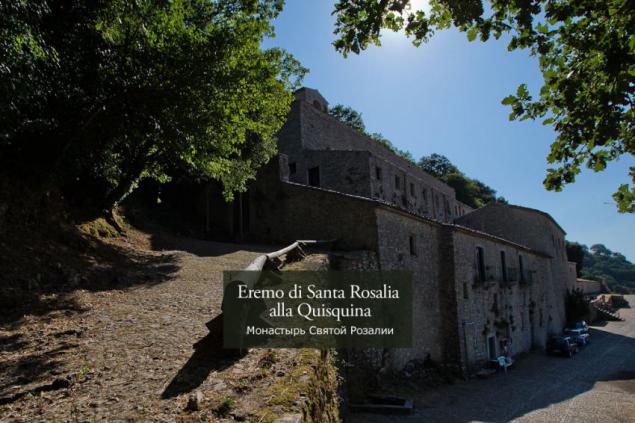
In the XVIII century Convent of St. Rosalia has become one of the most famous in Sicily. It was visited by the bishops, princes and cardinals, leaving generous donations. Gradually the monastery finish building, expanding, and soon it became live about 100 chelvoeka. At the same time his brother was never more than 10. In the monastery came together a lot of different people - from simple poor people, who saw in the monastery to survive, to the fugitives, so needed a rigorous selection process. Go ispytatetlny term duration of 1 year is not able to all newcomers. At the end of the XIX century monastery brotherhood and fell into disrepair. Remained alive only a few brothers. The last was the brother Viche (Vincenzo), who lived alone last years of his life and died in 1985 at the age of 92 years. Now from the monastery turned into a museum, but to be honest, it seems that there just left the last monk - there is still present.
Here it is, the entrance to the cave, where twelve years spent in prayer Rosalia Sinibaldi. Climb into her tiny "cell" do not yet so simple - you need to squeeze between the narrow walls of the cleft in the rock, and somewhere to crawl on his knees.

Here lived a pious Rozalia. Asceticism in this way, in my opinion, the most difficult vow, which can give a religious person. It is hard to imagine how one could live.

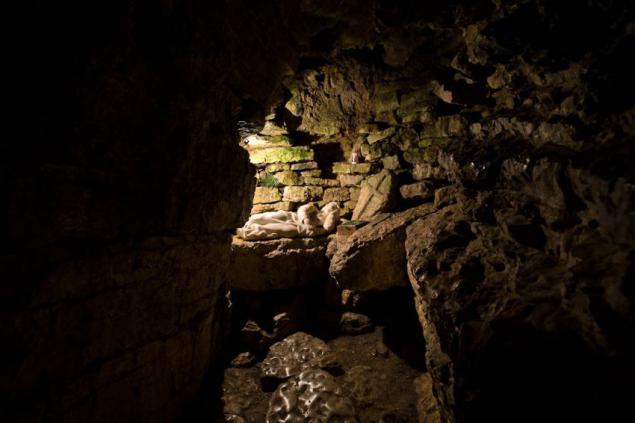
A stone's throw from the cave - inside the monastery church.

"God has many ways to communicate, but it certainly does not appeal to you on a cell phone. Therefore, turn it off ».

In the monastic cells all left as it was during the life of the home.

That's the way to live hermits. They did not talk much, many had a vow of silence.
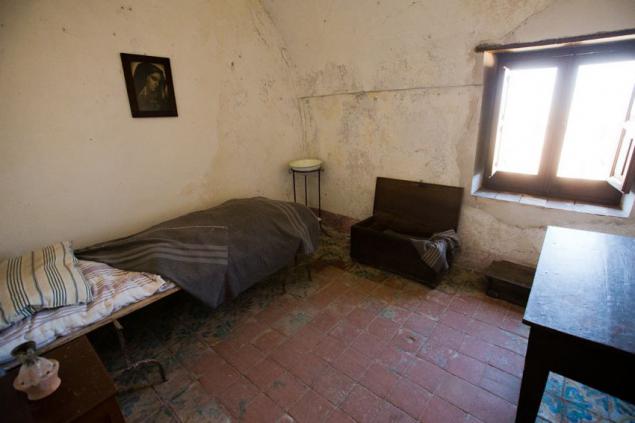
Cell last brother Vincenzo. He died in 1985 at the age of 92 years. On the bed lay his outer garment in which he was held for several decades. This is something like a cloak with a hood made of heavy, self-made material. Semi-circular piece of iron on the floor - warmer bed. Put it under a blanket and placed into the bowl with the coals. So monks warmed his icy bed during the winter.

Lata-patched blanket in one of the cells.

The windows of all Monash cells go just to the north.

The toilet was invented system for flushing wastes so that they fell on farmland as fertilizer. Here, too, is a brazier of coals, to somehow keep warm.

Here crushed grapes and making wine. Food supplies to make serious, because in the winter in the mountains are often a lot of snow and then the monastery appears absolutely cut off from the outside world.

There were two ovens - one for cooking, one for baking bread.

There did olive oil.
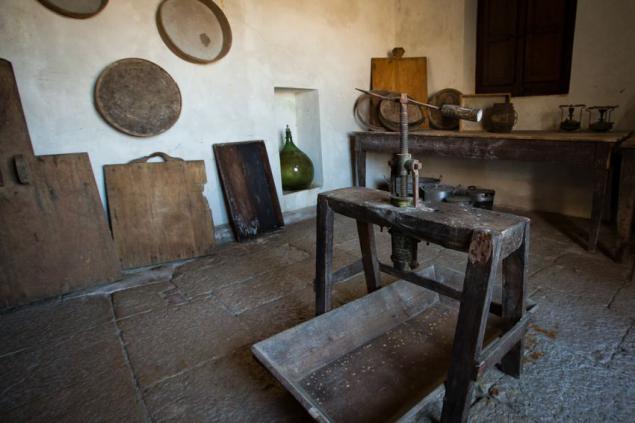
Loom.
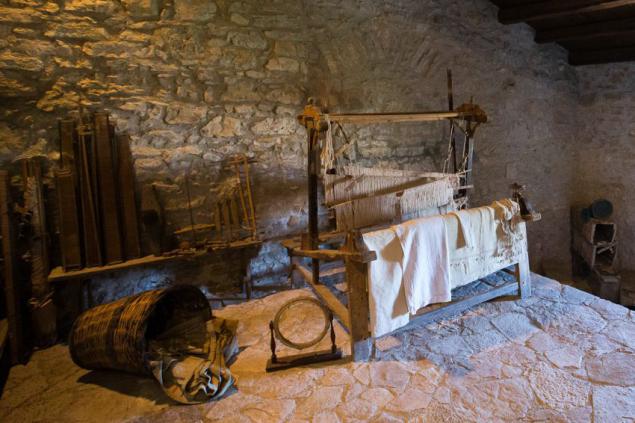
Room Prince Ventimiglia, who at one time was actively involved in the expansion of the monastery. The bed - several types of heaters with coals.

In the monastery fraternity members were not buried and mummified. The technology was similar to the one used Capuchin monks. The body of the deceased is hermetically sealed for a period of 6 to 8 months in order to save him from all liquids. Then the dried body was treated with aromatic herbs and vinegar, and then hung out to dry on one of the trees in front of the monastery, then the body of the deceased was placed in one of the niches in the wall of the crypt.
When the required space for the new dead, opened the hatch so-called "Ossuary" (he was on the floor in the center of the room) and the remains of one of the brothers sbrasyvalituda, and the skull was put on the shelf.



Left - the camera, where to put the body of the deceased to dry.

The tradition of mummification is associated with the philosophy of hermits: earthly life for them only a stage during which we must earn the right to eternal life and death - a long-awaited transition from one stage to another. Brothers greeted each other with these words: "Remember that you must die».

Now the monastery is under the control of the organization Pro Loco (Society for the preservation and promotion of local culture) Santo Stefano Kviskviny.

Source: drugoi.livejournal.com
A monastery, which I'm going to tell, there was where in 1624, two local residents found the very first cave where Rosalia held for twelve years. Cave found on the inscription on the stone: «Ego Rosali Sinibaldi quisquine et rosarum domini filia amore Domini Mei Jesu Cristi ini hoc antro habitari decrevi» (in Russian something like this: "I, Rosalia Sinibaldi, the daughter of the owner of these forests, decided to live in this cave of love for the Lord God Jesus Christ. "The discovery was seen as a miracle, and at this point there was a chapel.
A few years later a merchant from Genoa Francesco Skassi heard the story of Saint Rosalia, decided to go to Sicily and invest all your money in the construction of the monastery. After that, he stayed in the monastery to form with three hermits independent Brotherhood followers Saint Rosalia. Over time, the Brotherhood was able to organize your life in such a way as to be completely independent from the outside world: in addition to cooking, they grew vegetables, made bread, wine, fabrics, shoes, and everything else needed for a simple life of monks, hermits.

In the XVIII century Convent of St. Rosalia has become one of the most famous in Sicily. It was visited by the bishops, princes and cardinals, leaving generous donations. Gradually the monastery finish building, expanding, and soon it became live about 100 chelvoeka. At the same time his brother was never more than 10. In the monastery came together a lot of different people - from simple poor people, who saw in the monastery to survive, to the fugitives, so needed a rigorous selection process. Go ispytatetlny term duration of 1 year is not able to all newcomers. At the end of the XIX century monastery brotherhood and fell into disrepair. Remained alive only a few brothers. The last was the brother Viche (Vincenzo), who lived alone last years of his life and died in 1985 at the age of 92 years. Now from the monastery turned into a museum, but to be honest, it seems that there just left the last monk - there is still present.
Here it is, the entrance to the cave, where twelve years spent in prayer Rosalia Sinibaldi. Climb into her tiny "cell" do not yet so simple - you need to squeeze between the narrow walls of the cleft in the rock, and somewhere to crawl on his knees.

Here lived a pious Rozalia. Asceticism in this way, in my opinion, the most difficult vow, which can give a religious person. It is hard to imagine how one could live.


A stone's throw from the cave - inside the monastery church.

"God has many ways to communicate, but it certainly does not appeal to you on a cell phone. Therefore, turn it off ».

In the monastic cells all left as it was during the life of the home.

That's the way to live hermits. They did not talk much, many had a vow of silence.

Cell last brother Vincenzo. He died in 1985 at the age of 92 years. On the bed lay his outer garment in which he was held for several decades. This is something like a cloak with a hood made of heavy, self-made material. Semi-circular piece of iron on the floor - warmer bed. Put it under a blanket and placed into the bowl with the coals. So monks warmed his icy bed during the winter.

Lata-patched blanket in one of the cells.

The windows of all Monash cells go just to the north.

The toilet was invented system for flushing wastes so that they fell on farmland as fertilizer. Here, too, is a brazier of coals, to somehow keep warm.

Here crushed grapes and making wine. Food supplies to make serious, because in the winter in the mountains are often a lot of snow and then the monastery appears absolutely cut off from the outside world.

There were two ovens - one for cooking, one for baking bread.

There did olive oil.

Loom.

Room Prince Ventimiglia, who at one time was actively involved in the expansion of the monastery. The bed - several types of heaters with coals.

In the monastery fraternity members were not buried and mummified. The technology was similar to the one used Capuchin monks. The body of the deceased is hermetically sealed for a period of 6 to 8 months in order to save him from all liquids. Then the dried body was treated with aromatic herbs and vinegar, and then hung out to dry on one of the trees in front of the monastery, then the body of the deceased was placed in one of the niches in the wall of the crypt.
When the required space for the new dead, opened the hatch so-called "Ossuary" (he was on the floor in the center of the room) and the remains of one of the brothers sbrasyvalituda, and the skull was put on the shelf.



Left - the camera, where to put the body of the deceased to dry.

The tradition of mummification is associated with the philosophy of hermits: earthly life for them only a stage during which we must earn the right to eternal life and death - a long-awaited transition from one stage to another. Brothers greeted each other with these words: "Remember that you must die».

Now the monastery is under the control of the organization Pro Loco (Society for the preservation and promotion of local culture) Santo Stefano Kviskviny.

Source: drugoi.livejournal.com


